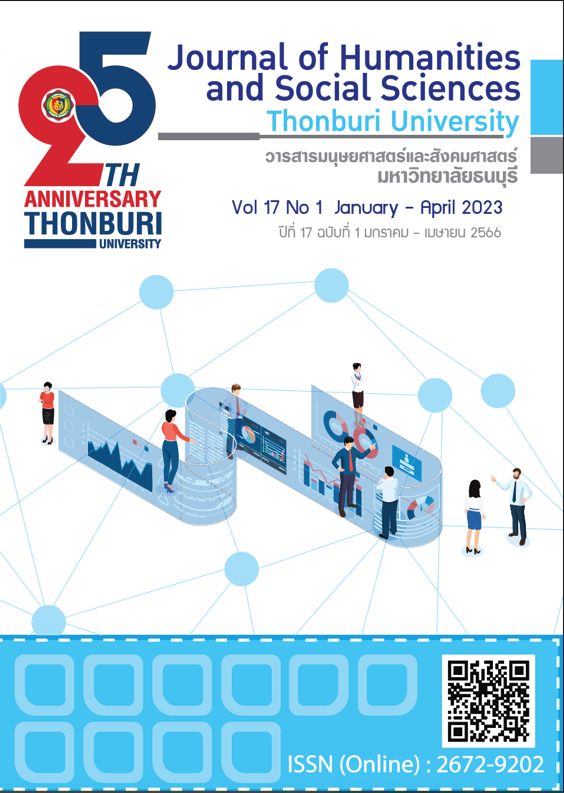แนวทางการพัฒนาการท่องเที่ยวคุณภาพจังหวัดกาญจนบุรีหลังสถานการณ์โควิด 19
คำสำคัญ:
แนวทางการพัฒนา, ศักยภาพการท่องเที่ยว, วิถีปกติใหม่, สถานการณ์โควิด 19บทคัดย่อ
บทความนี้เป็นของโครงการวิจัยได้รับทุนอุดหนุนการวิจัยจากมหาวิทยาลัยมหิดล มีวัตถุประสงค์เพื่อศึกษาศักยภาพและแนวทางการพัฒนาการท่องเที่ยวคุณภาพจังหวัดกาญจนบุรีหลังสถานการณ์โควิด 19 รูปแบบการวิจัยเชิงคุณภาพด้วยวิธีเจาะจงและลูกโซ่ แบบสัมภาษณ์กึ่งโครงสร้าง และการสังเกตแบบมีส่วนร่วม จากข้าราชการ นักวิชาการการท่องเที่ยว ผู้ประกอบการท่องเที่ยว และปราชญ์ชุมชน จำนวน 20 คน การศึกษาได้ผลดังนี้ คือ 1) จังหวัดกาญจนบุรีมีแหล่งท่องเที่ยวครบทุกประเภทซึ่งสามารถจำแนกเป็นแหล่งท่องเที่ยวหลัก 91 แหล่ง กลุ่มเป้าหมายส่วนใหญ่เป็นนักท่องเที่ยวชาวไทย (ร้อยละ 95) จากสถานการณ์การแพร่ระบาดของไวรัสโควิด 19 ภาครัฐใช้มาตรการควบคุมอย่างเข้มงวดทำให้จำนวนนักท่องเที่ยวลดลง เมื่อสถานการณ์คลี่คลายลงได้รับการยกระดับให้เป็นจังหวัดนำร่องเพื่อการท่องเที่ยวเนื่องจากมีแหล่งท่องเที่ยว จำนวนมาก มีที่พัก สิ่งอำนวยความสะดวก กิจกรรม และการเข้าถึง
ที่หลากหลายทำให้นักท่องเที่ยวเพิ่มขึ้นอย่างต่อเนื่อง แม้นักท่องเที่ยวจะเพิ่มขึ้นในช่วงที่ผ่านมาแต่รายได้จากการท่องเที่ยวกลับน้อยลง ดังนั้นจึงจำเป็นต้องมีการปรับเปลี่ยนทิศทางการท่องเที่ยวของจังหวัดไปสู่การท่องเที่ยวที่มีคุณภาพ
2) แนวทางการพัฒนาการท่องเที่ยวจังหวัดกาญจนบุรีให้มีศักยภาพสูงหลังสถานการณ์โควิด 19 ประกอบด้วย การพัฒนาพื้นที่ในเขตเศรษฐกิจพิเศษและพื้นที่โดยรอบ การพัฒนาการท่องเที่ยวที่เป็นมิตรต่อสิ่งแวดล้อมบนฐานความคิดสร้างสรรค์และนวัตกรรม การจัดระเบียบแหล่งท่องเที่ยวให้สอดคล้องกับมาตรการผ่อนคลาย การพัฒนายกระดับมาตรฐานสินค้าและบริการด้านการท่องเที่ยวให้ได้เครื่องหมายรับรองมาตรฐาน การเตรียมบุคลากรเพื่อรองรับการเปลี่ยนแปลงการท่องเที่ยวในอนาคตและการพัฒนาสื่อและโปรแกรมการท่องเที่ยวให้เหมาะสมกับกลุ่มเป้าหมาย
เอกสารอ้างอิง
กรกนก นิลดำ (2563). การสร้างการเล่าเรื่องของแหล่งท่องเที่ยวเชิงสุขภาพในจังหวัดเชียงราย. วารสารนิเทศศาสตร์ธุรกิจบัณฑิตย์, 14(2), 109-135.
กรมการท่องเที่ยว. (2563). ข้อมูลสถิตินักท่องเที่ยว. สืบค้นเมื่อ 7 กุมภาพันธ์ 2563, จาก https://www.mots.go.th
เกษรา โพธิ์เย็น. (2562). สังคมผู้สูงอายุ:โอกาสของธุรกิจที่ยั่งยืนในอนาคต. วารสารวิทยาการจัดการปริทัศน์, 21(1), 201-209.
นุชประวีณ์ ลิขิตศรัณย์. (2562). ศักยภาพแหล่งท่องเที่ยวของจังหวัดพิจิตร. วารสารการบริการและการท่องเที่ยวไทย, 14(1), 28-41.
บุญเลิศ จิตตั้งวัฒนา. (2548). การวางแผนพัฒนาการท่องเที่ยวแบบยั่งยืน. เชียงใหม่: คณะมนุษยศาสตร์ สำนักพิมพ์มหาวิทยาลัยเชียงใหม่.
ประชาชาติธุรกิจ. (2563). ททท.เปิดยุทธศาสตร์ปี 2020 Go Quuality หนุนเติบโต “มั่นคง”. สืบค้นเมื่อ 7 กุมภาพันธ์ 2563 จาก http://www.prachachat.net/tourism/news-347053
ศิริเพ็ญ ดาบเพชร. (2561). องค์ประกอบการท่องเที่ยวและช่องทางการสื่อสารภาพลักษณ์การท่องเที่ยวสำหรับกลุ่มนักท่องเที่ยวอนาคต กรณีศึกษาจังหวัดพิษณุโลก. วารสารการวิจัยเพื่อพัฒนาชุมชน (มนุษยศาสตร์และสังคมศาสตร์). 11(1), 79-98.
ศูนย์วิจัยกสิกรไทย. (2563). COVID-19 ฉุดการท่องเที่ยวโลกหยุดชะงัก คาด…ทั้งปีหดตัว 38-45%. สืบค้นเมื่อ 29 มิถุนายน 2563, จาก https://kasikornresearch.com/th/analysis/k-social-media/Pages/COVID-19-World-Tourism.aspx
สำนักงานจังหวัดกาญจนบุรี. (2563). แผนพัฒนาจังหวัด. สืบค้นเมื่อ 7 กุมภาพันธ์ 2563, จาก https:// ww2.kanchanaburi.go.th
สุภางค์ จันทวานิช. (2557). วิธีการวิจัยเชิงคุณภาพ. กรุงเทพฯ: สำนักพิมพ์แห่งจุฬาลงกรณ์มหาวิทยาลัย.
Becker, G. S. (1962). Investment in human capital: A theoretical analysis. Journal of political economy, 70 (5, Part 2), 9-49.
Chen, H., & Rahman, I. (2018). Cultural tourism: An analysis of engagement, cultural contact, memorable tourism experience and destination loyalty. Tourism Management Perspectives.
Christia, J., & Ard, A. (2016). The Influence of demogaphic characteristic on service quality perceptions. Journal of Marketing Management, 4, 57-62.
Dickman, S. (1996). Tourism: An Introductory Text. 2nded. Sydney: Hodder Education.
Dwyer, L., & Kim, C. (2003). Destination competitiveness: Determinats and indicator. Current Issues in Tourism, 6(5), 369-414.
Huang, H. (2019). The Tourism Industry Development Strategy in Bangkok of Thailand. (Master’s Thesis). Siam University, Bangkok.
Lexhagen, M. (2008). Customer perceived value of travel and tourism websites. Retrieved from http://innopp.no/docs/ni_kunnskap/rapporter/Custumerpercent_valuepercent_WP.pdf
Litvina, S. W., Goldsmithb, R. E., & Pana, B. (2008). Electronic word-of-mouth in hospitality and tourism management. Tourism Managemesnt, 29(3), 458-468.
McKercher, B. (1998). The effect of market access on destination choice. Journal of Travel Research, 37(3), 39-47.
Raymond. C. (2008). The practical challenges of developing creative tourism: a cautionary tale from New Zealand. In Creative tourism, a global conversation: how to provide unique creative experiences for travelers worldwide, ed. By Wurzburger, R., Aageson, T., Pattakos, A., and Pratt, S. Santa Fe. New Mexico: Sunstone Presss.
Swarbrooke, J. (1998). Sustainable Tourism Management Wallingford. Oxon: CABI Publishing.
Xiang, Z., & Gretzel, U. (2010). Role of social media in online travel information search. Tourism Management, 31(2, 179-188.
Translated Thai References
Chantavanich, S. (2014). Quality research. Bangkok: Chulalongkorn University Press. (in Thai)
Dabphet, S. (2018). Tourism Attributes and Communication Channels of Tourism Image for Future Tourists: The Case of Phitsanulok. Journal of Community Development Research (Humanities and Social Sciences). 11(1), 79-98. (in Thai)
Department of Tourism. (2020). Tourists Statistics. Retrieved February 7, 2020, from https://www.mots. go.th (in Thai)
Jittungwattana, B. (2005). Sustainable Tourism Development Planning. Chiang Mai. Faculty of Humanities, Chiang Mai University Press. (in Thai)
Kasikornthai Research Center. (2563). COVID-19 Traces the World Tourism Disruption Expected ... contract year by 38-45%. Retrieved June 29, 2020, from https://kasikornresearch.com/th/-analysis/k-social-media/Pages/COVID-19-World-Tourism.aspx (in Thai)
Likitsarun, N. (2019). The Potentials of Tourism Attraction in Phichit Province. Journal of Thai Hospitality and Tourism, 14(1), 28-41. (in Thai)
Nindum, K. (2520). Creation Storytelling of Health Tourism Sites in Chiang Rai. Dhurakij Pundit Communication Arts Journal, 14(2), 109-135. (in Thai)
Phoyen, K. (2019). Aging Society: Opportunities for the Future Sustainable Business Journal of Management Science Review, 21(1), 201-209. (in Thai)
Prachachatturakit. (2520). TAT unveils strategy for 2020, Go Quaality Thanatorn “Confident”. Retrieved February 7, 2020, from http://www.prachachat.net/tourism/news-347053 (in Thai)
The kanchanaburi Provincial. (2020). Provincial Development Plan. Retrieved February 7, 2020, from https://ww2.kanchanaburi.go.th (in Thai)
ดาวน์โหลด
เผยแพร่แล้ว
รูปแบบการอ้างอิง
ฉบับ
ประเภทบทความ
สัญญาอนุญาต
ลิขสิทธิ์ (c) 2022 เฉลิมพล ศรีทอง

อนุญาตภายใต้เงื่อนไข Creative Commons Attribution-NonCommercial-NoDerivatives 4.0 International License.
ผลงานที่ปรากฎในวารสารฉบับนี้เป็นลิขสิทธิ์เฉพาะส่วนบุคคลของผู้เขียนซึ่งต้องรับผิดชอบต่อผลทาง กฎหมายที่อาจเกิดขึ้นได้และไม่มีผลต่อกองบรรณาธิการ






